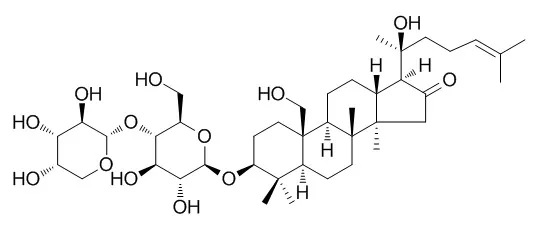| Description: |
Bacoside A has a possible anticancer activity that could be inducing cell cycle arrest and apoptosis through Notch pathway in GBM in vitro. It exerts cytoprotective efficacy by attenuation of ROS generated through oxidative stress by an increase in the concentration of antioxidant enzymes and sustain membrane integrity which leads to restoring the damage caused by tBHP.
Bacoside A can able to inhibit the progression of Experimental Autoimmune Encephalomyelitis (EAE) may be by the inhibition of inflammatory cytokines and chemokine evolved during active EAE.
Bacoside A also has vasorelaxation. |
| Targets: |
ROS | eNOS | BDNF1 | FOXP3 | TNF-α | IL recepter | MMP |
| In vitro: |
| Molecules. 2019 Jun 15;24(12). pii: E2243. | | Vasodilatory Effects and Mechanisms of Action of Bacopa monnieri Active Compounds on Rat Mesenteric Arteries.[Pubmed: 31208086 ] | B. monnieri extract (BME) is an abundant source of bioactive compounds, including saponins and flavonoids known to produce vasodilation. However, it is unclear which components are the more effective vasodilators. The aim of this research was to investigate the vasorelaxant effects and mechanisms of action of saponins and flavonoids on rat isolated mesenteric arteries using the organ bath technique.
METHODS AND RESULTS:
The vasorelaxant mechanisms, including endothelial nitric oxide synthase (eNOS) pathway and calcium flux were examined. Saponins (Bacoside A and bacopaside I), and flavonoids (luteolin and apigenin) at 0.1-100 µM caused vasorelaxation in a concentration-dependent manner. Luteolin and apigenin produced vasorelaxation in endothelial intact vessels with more efficacy (Emax 99.4 ± 0.7 and 95.3 ± 2.6%) and potency (EC50 4.35 ± 1.31 and 8.93 ± 3.33 µM) than Bacoside A and bacopaside I (Emax 83.6 ± 2.9 and 79.9 ± 8.2%; EC50 10.8 ± 5.9 and 14.6 ± 5.4 µM). Pretreatment of endothelial intact rings, with L-NAME (100 µM); an eNOS inhibitor, or removal of the endothelium reduced the relaxant effects of all compounds. In K+-depolarised vessels suspended in Ca2+-free solution, these active compounds inhibited CaCl2-induced contraction in endothelial denuded arterial rings. Moreover, the active compounds attenuated transient contractions induced by 10 µM phenylephrine in Ca2+-free medium containing EGTA (1 mM). Thus, relaxant effects occurred in both endothelial intact and denuded vessels which signify actions through both endothelium and vascular smooth muscle cells.
CONCLUSIONS:
In conclusion, the flavonoids have about twice the potency of saponins as vasodilators. However, in the BME, there is ~20 × the amount of vaso-reactive saponins and thus are more effective. | | Pathophysiology. 2018 Jun;25(2):143-149. | | Attenuation of cytotoxicity induced by tBHP in H9C2 cells by Bacopa monniera and Bacoside A.[Pubmed: 29678356] | Cardiovascular diseases are one of the major global health issues leading to morbidity and mortality across the world. In the present study Bacopa monniera and its major bioactive component, Bacoside A (Bac-A) was used to evaluate its cytoprotective property in H9C2 cardiomyocytes against tBHP (150 μM) induced ROS-mediated oxidative stress and apoptosis.
METHODS AND RESULTS:
Our results implicate that pre-treatment with hydroalcoholic extract of Bacopa monniera (BME) and Bac-A (125 μg/ml and 6 μg/ml respectively) significantly restored oxidative stress by scavenging the free radicals and also elevated phase II antioxidant defensive enzymes such as (SOD, CAT, GR, GPx and GSH). Membrane integrity was estimated by MMP and LDH assays and found 89 and 72% of the protective effect. Further immunoblotting studies confirmed anti-apoptotic effects by regulating protein expression like Bcl2 was up-regulated to 99 and 85% and Bax was down-regulated to 122 and 181%, iNOS by 154.38 and 183.45% compared to tBHP (277.48%) by BME and Bac-A.
CONCLUSIONS:
BME and Bac-A exerts cytoprotective efficacy by attenuation of ROS generated through oxidative stress by an increase in the concentration of antioxidant enzymes and sustain membrane integrity which leads to restoring the damage caused by tBHP. |
|
| In vivo: |
| Biomed Pharmacother. 2019 Jan;109:1339-1345. | | Bacoside-A inhibits inflammatory cytokines and chemokine in experimental autoimmune encephalomyelitis.[Pubmed: 30551384 ] | Chronic inflammation of the myelin sheath is the crucial event behind the progression of multiple sclerosis (MS). Bacoside A is one of the major constituents obtained from Bacopa monerii (L.) Wettst., and possess neuroprotective as well as anti-inflammatory actions.
METHODS AND RESULTS:
The current study explores the effect of Bacoside A in acute and chronic models of Experimental Autoimmune Encephalomyelitis (EAE). The results indicate that the Bacoside A treated mice produced a significant reduction in disease score compared to disease control in both models. The treatment with Bacoside A downregulated the inflammatory cytokines (IL-6, IL-17a, and TNFα) and inflammatory chemokine CCL-5 in EAE mice. On the other hand, Bacoside-A treated mice showed a nonsignificant effect on promoting the expressions of NCAM, BDNF1, and FOXP3 in acute and chronic models of EAE. Histopathological analysis revealed that the Bacoside A treated mice at a dose of 10 mg/kg exhibited a significant reduction in cellular infiltrations, cellular changes, and demyelination in cerebral tissues, but unable to protect at a higher dose in both models.
CONCLUSIONS:
In conclusion, Bacoside A can able to inhibit the progression of EAE may be by the inhibition of inflammatory cytokines and chemokine evolved during active EAE. |
|






 Cell. 2018 Jan 11;172(1-2):249-261.e12. doi: 10.1016/j.cell.2017.12.019.IF=36.216(2019)
Cell. 2018 Jan 11;172(1-2):249-261.e12. doi: 10.1016/j.cell.2017.12.019.IF=36.216(2019) Cell Metab. 2020 Mar 3;31(3):534-548.e5. doi: 10.1016/j.cmet.2020.01.002.IF=22.415(2019)
Cell Metab. 2020 Mar 3;31(3):534-548.e5. doi: 10.1016/j.cmet.2020.01.002.IF=22.415(2019) Mol Cell. 2017 Nov 16;68(4):673-685.e6. doi: 10.1016/j.molcel.2017.10.022.IF=14.548(2019)
Mol Cell. 2017 Nov 16;68(4):673-685.e6. doi: 10.1016/j.molcel.2017.10.022.IF=14.548(2019)